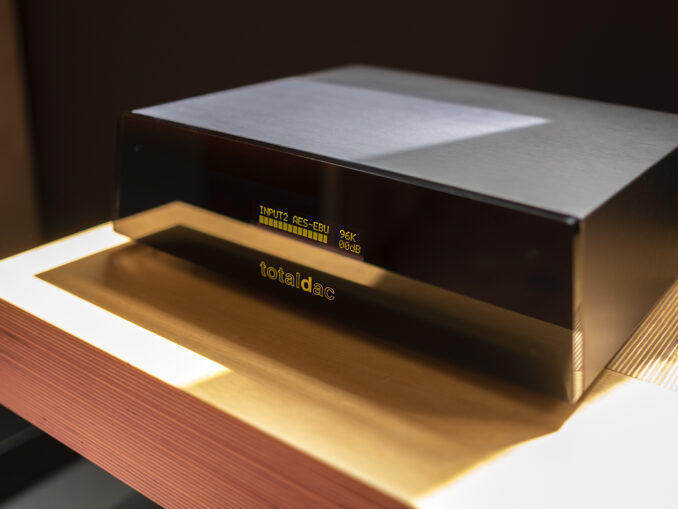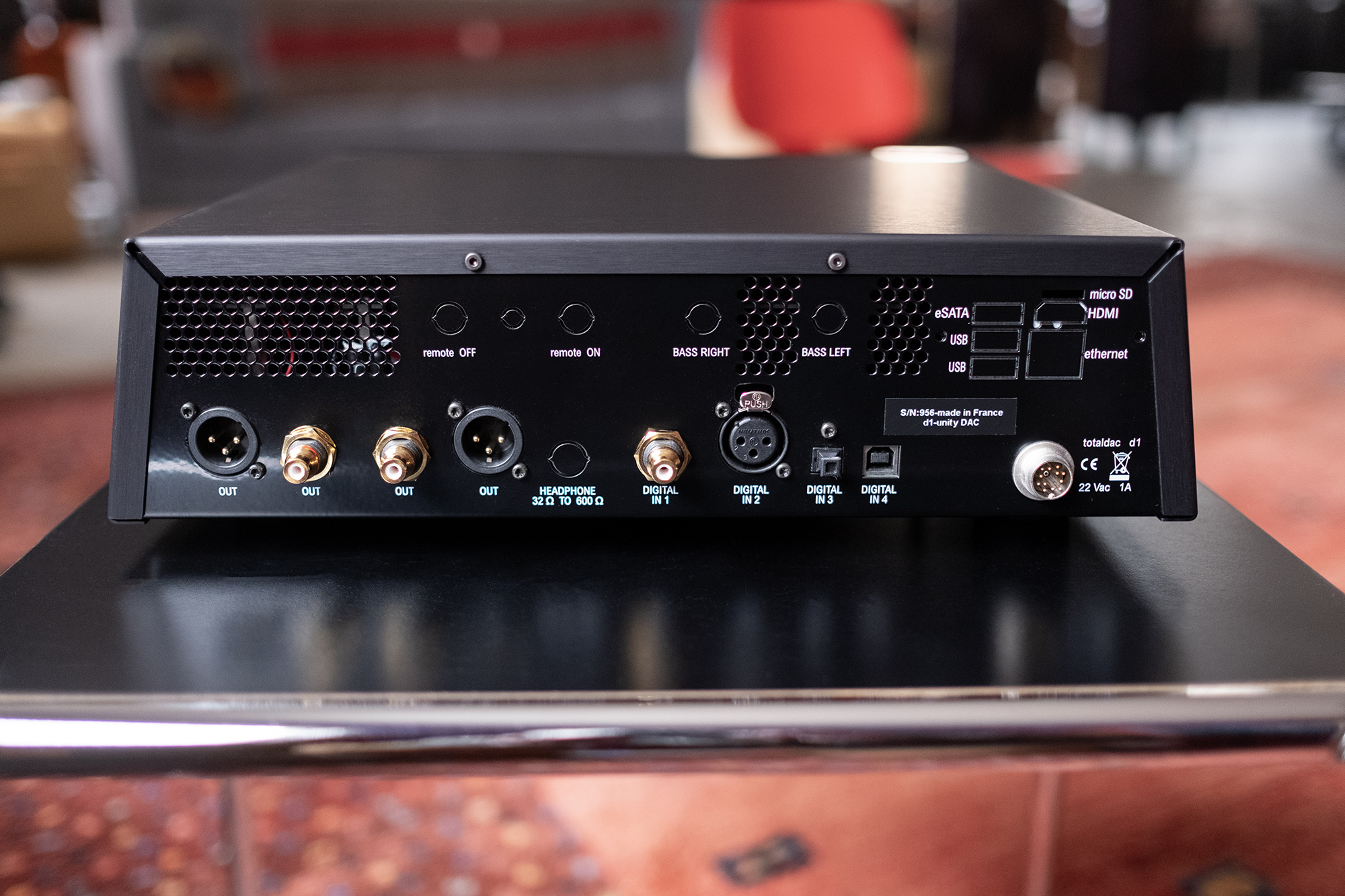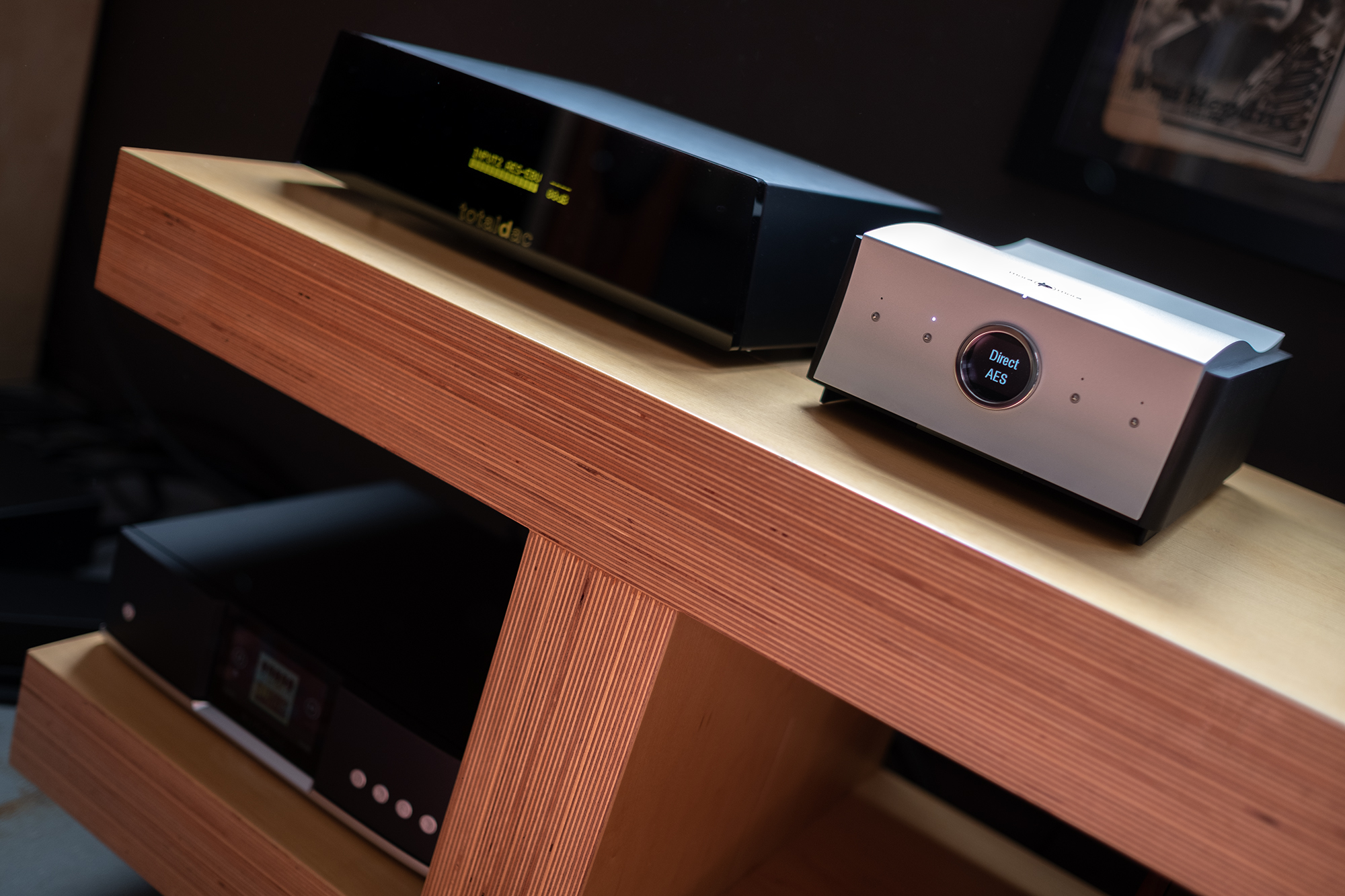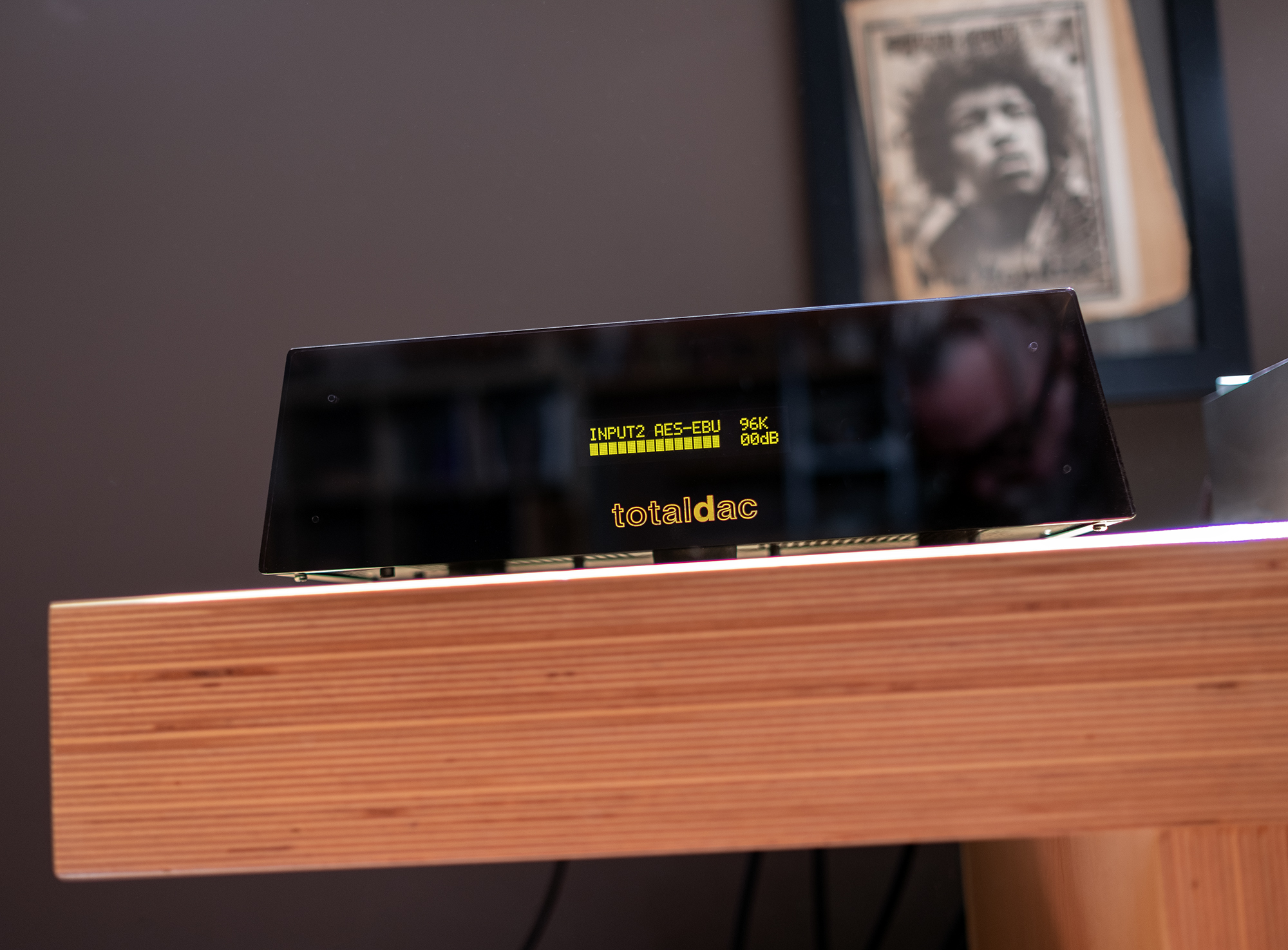
I’ve been living with DACs from France’s totaldac for the past ten years, giver or take, and the reason is simple—I love listening to music through them.
That’s right, love not like because I listen to music as a kind of medicine, a form of meditation, a daily healing ritual that soothes and moves, while expanding my internal library of the endless possibilities that music, and the people who make it, have to offer.
We bought our home, in part, because it came with a barn, the Barn, the place where I work and the place where music plays 24/7 (there’s always something breaking in). Down a private dirt road miles from any highway, the Barn is also a quiet place (ambient noise level in the Barn sits at 31dB(A)) that measures exceptionally well as a place to listen to music and zoom in on the gear that’s responsible for its making. All to say, I put our money where my love of listening to music on the hifi is, a serious commitment to work and play (I also have a few guitars scattered around the place which I play poorly).
When talking DACs, I’ve reviewed more than a hundred between my combined 10+ years as Editor of AudioStream and Twittering Machines, ranging in price from $99 to $25k+, and a totaldac has been my DAC of choice for just about as long. I’ve reviewed five totaldac DACs, not counting this d1-unity, in that time and one, or two, always sit on my list of favorite DACs. Why? Because I love listening to music through them.

The basic D to A recipe found in every totaldac is its reliance on a series of Vishay Precision Group’s 0.01%-tolerance VAR-series Bulk Metal Foil resistors, the exact number varies according to model, arranged as a discrete R2R (Resistor Ladder) DAC. Vincent Brient, totaldac’s founder and designer, also employs an FPGA (Field Programmable Gate Array) that buffers and reclocks incoming data, and is also home to a user-selectable finite impulse response (FIR) compensation filter, that ‘corrects’ for the non-oversampling DAC’s frequency dip above 20kHz (3dB down at 20kHz, according to Brient). The power supply for every totaldac resides in its own matching trapezoidal enclosure, far away from the DAC-proper to keep its noise away from the audio signal.
The new Unity line of DACs from totaldac is comprised of three models: the d1-unity, d1-triunity, and the d1-sublime, which cost 11500euros excl VAT, 22000euros excl VAT, and 46000euros excl VAT respectively.
From totaldac:
The “unity” architecture allows a better clock distribution, a lower jitter, a lower R2R power supply rail impedance and a lower noise in the digital section.
The output stage is also fully new, in term of components and in term of schematics, and using discrete components exclusively.
This new output stage produced a 3.5V unbalanced signal and a 7V balanced signal with low impedance for the best versatility, to be connected to all preamps, all integrated amps and also directly to all power amps.

The d1-unity employs one R2R DAC per side (100 Vishay Foil Resistors in each) and offers the typical totaldac ins and outs including AES (my preferred method of connecting to a totaldac), USB, Toslink, and Coax S/PDIF. An included plastic remote provides access to input selection, volume control, and a number of setup functions including PHASE, EARTH (when “CONNECTED” is selected the signal ground is connected to the earth. When “UNCONNECTED” is selected the signal ground and the earth are isolated), DISPLAY (on/off), and TREBLE FIR (When “ON” is selected the non-oversampling treble loss is compensated to get a flat frequency response. When “OFF” is selected the DAC is a pure NOS (non-oversampling) DAC with some treble attenuation in case of 44.1KHz or 48KHz sampling frequency).

I own the totaldac d1-tube DAC/Streamer (review) which, as its name suggests, includes totaldac’s optional streaming board inside and also houses 100 Vishay Foil Resistors per side but I used its AES input, fed from the Auralic ARIES G1.1 Streamer (review) which also fed the d1-unity for the duration of the review period. AES to AES, apples to apples. I also have on hand the lovely Mola Mola Tambaqui DAC (review) that comes in at $13,500.
The review system is comprised of the DeVore Fidelity O/96 loudspeakers and the Leben CS600X integrated amplifier with cables and a Niagara 3000 power conditioner from AudioQuest. A length of AQ Diamond AES cable mated the Auralic ARIES to the DACs while two pair of AQ ThunderBird RCA interconnects connected the DACs to the Leben, making the A/B process simply a matter of moving that AES cable from one DAC to another, switching inputs on the Leben, and adjusting volume level where needed. I maxed out both totaldac’s volume control for the duration of this review and used the Leben as integrated amp as intended and as I prefer.
As I shared with my dear friend Alex Halberstadt, resolution can be a tricky thing when it comes to digital—too much, and my focus shifts from music to sound; too little, and I become less engaged. Describing difference can be even trickier.
If we say that the difference between clarity and resolution is the difference between a clearer view and a more focused view, then describing one main difference between the d1-unity and d1-tube is a matter of greater clarity. This difference is easy to hear and even easier to feel, as it imbued each of the exotic and wondrously seductive sounds on Lucrecia Dalt’s stunning ¡Ay! with a greater sense of full voice, separation, and emotive impact. Listening to ¡Ay! through the d1-unity held more drama than through the d1-tube. It really is that obvious, especially when given more time to take hold.

I say more time because my initial, albeit fleeting, impression was that the d1-tube made things sound both sweeter and more appealing. The flute on opener “No Tiempo” sounding, initially, more full and flute-like. But after more time on each DAC, it became clear (see what I did there?) that my initial impression was mistaken and time proved that the d1-unity was offering a deeper and more fully formed flute with greater dimension, body, and solidity. This increased clarity was in no way less natural, in no way more etched or artificially resolute, and just felt more right. Stepping back from this flute-focused view, each sonic element gained greater clarity, voice, and impact making the whole that much more moving, which is exactly the direction I want to go.
“Figure 8” from FKA twigs’ 2015 EP M3LL155X is a tortuous temptress of a track, one I use to test the mettle of a DAC’s ability to unravel massed electronic mayhem and the d1-unity passed with flying colors (pun intended). Listening to “Figure 8” at copious volume levels, a thrill ride if ever there was one, proved that the d1-unity sounds more dynamic than the d1-tube, with seemingly greater speed and impact in attack combined with clearer and better fleshed out bass. There’s also a clear sense of greater micro- to macro- control when taken in a whole make this music feel more like a giant machine made of infinitesimally small parts and giant cogs all chugging together to form a locomotive of sound energy. Stunning.
While we’re in the torture track section of our listening notes, Alfred Schnittke’s Faust Cantata ranks among my favorites and by the time we arrive at “Es geschah…” all hell breaks loose (pun intended) with Inger Blom riding over the storm of orchestral+ sounds like some mad valkyrie summoning all manner of dark forces. With this track, the d1-tube’s bloomier and less distinct sound image added to the sheer drama by making every sonic element of Schnittke’s crazed tango-tinged descent into madness feel like one giant storm cloud rolling into the Barn. That said, even here and over more time the d1-unity’s clearer voice illuminated the inner workings and macro movements with more compelling voice and feel for the mechanics of this mad music.
Taking more than a step into a more peaceful sonic kingdom, The Rolling Stones “Lady Jane” from Flowers is simply lovely while offering its own form of sonic gymnastics with acoustic guitar, dulcimer, and harpsichord backing Mick’s vocals. Once again, the d1-unity gave each of these stringed instruments (a harpsichord plucks its strings) its own unique voice with greater difference, detail, and body than the d1-tube, where even Keith Richard’s acoustic guitar sounded more like the real thing, more fully formed. All of this more adds up to a more moving experience, a deeper dive into music’s workings.

With the Mola Mola Tambaqui’s AES input set to Direct mode, bypassing its internal volume control and connected to the Auralic ARIES with the same AQ AES cable, “Lady Jane” sounded very much like the totaldac d1-unity. Very much alike with a just bit more emphasis on upper frequencies with the Mola Mola, offering a bit more brightness to those same stringed instruments, pulling my attention to their bright strings strummed and plucked sounds, where the d1-unity moved my attention to body, tone, and texture. I tend to prefer the totaldac’s FIR filter off, but turning it on brought its sound closer to the Tambaqui in the upper registers. Not the same, but closer.
Antony and the Johnsons’ “One Dove” from The Crying Light is another go to track for its supreme beauty. Both of these fine DACs brought this heart breakingly lovely music to life in Barn and the differences between them were subtle. Beyond the aforementioned difference in upper frequencies, the totaldac seemed to imbue the space of this spacious recording with a bit more air, more atmosphere with the musicians and Anohni’s vocals feeling a touch softer and sweeter as compared to the Mola Mola but no less resolute.
I have to emphasize the subtle nature of these differences which took real care and time to fully suss out and I doubt that most listeners would hear the things I’m highlighting as differences or deficiencies without the benefit of direct comparison. Which is to say that the Mola Mola does not sound ‘hard’ or ‘lit up’ as one might take away from my comparative impressions, just as the totaldac does not sound ‘dark’ or ‘soft’. This also brings to mind Mark Twain’s observation which I’ll share yet again, “Comparison is the death of joy.”
But some people love to be told what to buy, and they want to know what’s Best. Which DAC is the winner, and which is the loser. What got blown away? Who got crushed? To my mind, when spending serious money on anything, any thing, the buyer has to do some work, even more so when that thing’s only job is to make music that compels its owner to listen more and listen more deeply.

If you want to know which of these DACs is better, you have to listen for yourself. There is no other way to know in a meaningful way. The AIRES G1.1 used for this review costs $3249, not an insignificant sum when added to the price of either DAC but I will note that I preferred the AIRES to the Tambaqui’s own Roon Ready Ethernet input. So in terms of sound quality alone, close your eyes and let chance pick the Best DAC. If you like the look of one over the other, or if you prefer the company story of one over the other, that’s as good a reason as any to make your selection.
I also know people who aren’t big fans of listening to music from digital sources and most of these same people want to invest in a digital to analog converter that makes music as compelling, as rich, as smooth, as colorful, and as moving as their preferred analog sources. In these cases, budgets permitting, I recommend a totaldac (any one that fits the numbers), the Mola Mola Tambaqui, or anything from dCS (but that memory is old and in need of an update). You also have to take care in how your digital gets to your DAC of choice and I certainly recommend the Auralic ARIES G.1.1 as one fine contender.

The totaldac d1-unity is as compelling a music source as I’ve had the pleasure to spend time with. It offers a clear improvement over the d1-tube DAC/Streamer which is why I’m keeping it and trading in the d1-tube, providing a more fully resolved and engaging picture of my most cherished music while enticing and encouraging exploration of the new. If you’re looking for a digital source that moves music so far into the foreground its origins become irrelevant, you owe it to your music to hear a totaldac d1-unity.

totaldac d1-unity DAC
Price: 12500euros incl VAT in Europe, 11500euros excl VAT out of Europe (appx $12,500USD)
Company Website: totaldac
Specifications
- 192KHz asynchronous Xmos USB, 192KHz coax RCA, 192KHz AES-EBU, 96KHz optical, selected from a remote control
- 44.1KHz, 48KHz, 88.2KHz, 96KHz, 176.4KHz and 192KHz, 16 to 24 bit formats supported
- as an option, DSD (DoP standard) supported on coax, AES-EBU and USB inputs
- embedded custom clock with anti-jitter FIFO memory
- 3.5Vrms max RCA, 7Vrms max XLR analog output
- volume control, adjusted by a remote control and an OLED display, works for all inputs
- phase polarity selected by remote control
- non-oversampling DAC compensation filter activated or disactivated by remote control
- display switched off by remote control
- R2R DAC technology using 100 pieces of 0.01% VAR Bulk Metal® Foil resistors Vishay Foil Resistors
- class A discrete transistor output stage
- external power supply to minimize the noise on the embedded preamp
- aluminium and PMMA enclosure with massive pure copper antivibration plate
- power consumption 14.2W @44.1KHz, 16.5W @192KHz
- DAC dimensions: height 110mm, width 360mm, depth 290mm
- power supply dimensions: height 65mm, width 122mm, depth 180mm
- weight: 7kg.

